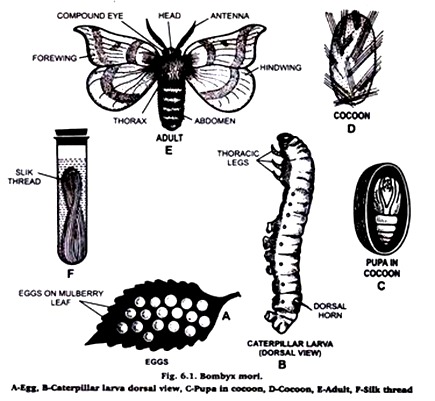In this article we will discuss about the life history of silk worms.
Classification:
Phylum: Arthropoda jointed appendage,
Class: Insects 3 pairs of legs
ADVERTISEMENTS:
Sub-class: Pterygota Wings present
Order: Lepidoptera Two pairs of membranous wings
Type: Bombyx mori
Habit and habitat:
ADVERTISEMENTS:
Above insect is dioecious and is found on leaves of mulberry plant.
Distribution:
Silk worms are found in India, Japan, China, South Korea and Russia.
Comments:
ADVERTISEMENTS:
1. Commonly called as silk worm or silk moth.
2. Adult female moth measures 24-25 mm in length and 40-50 mm with expanded wings.
3. Body divided into head, thorax and abdomen.
4. Head contains a pair of plumed (branched) antennae, compound eyes and mouthparts.
5. Life-cycle consists of egg, caterpillar, larva, pupa, imago and adult. Each female moth after copulation lays 400-500 eggs. Eggs hatch into caterpillar larva which feeds vigorously on mulberry leaves then it pupates and cocoon is formed. Cocoon is the result of secretion of silk thread in and around cocoon. Length of continuously thread measures 1000-1200 meter.
6. Various silk worms besides Bombyx mori (mulberry silkworm) are Antheraea assamensis (Muga silkworm) Antheraea mylitta (Tussora silkworm). A. pernyl (Oak silkworm). Attacus atlas (eri silkworm).
Economic importance:
Silk worm is economically very important insect. Silk is the pasty secretion secreted from silk glands (modified salivary glands). As the secretion comes in contact with air, it becomes tough fibrous thread. Silk fabrics are elegant garments used for making saries shawls, shirts, jackets and Kurtas. Silk is also used in making parachutes, parachute cords, fishing lines, insulation coil for telephones and wireless receivers.
